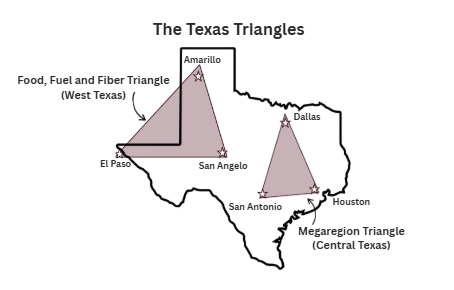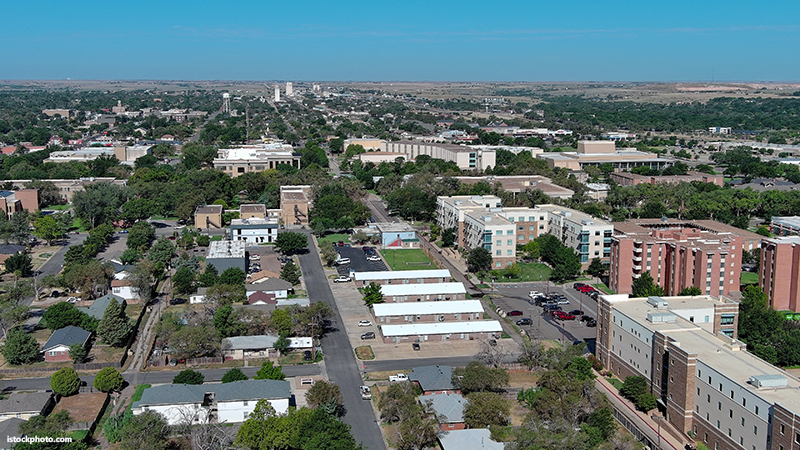

Seventh in a series on the Texas Triangles.
More than a campus, a catalyst.
Location plays a significant role in college attendance. Post-secondary educational attainment levels are higher in Tom Green (Angelo State University), Lubbock (Texas Tech University), El Paso (The University of Texas at El Paso) and Ector (The University of Texas-Permian Basin) counties compared to “further out” rural counties in Texas. In Randall County, West Texas A&M University has the highest bachelor’s participation in rural West Texas at a rate of 35%. In comparison, the average educational attainment for the West Texas Triangle is 25% in counties with universities, falling to 20% when no university is located there. This does not suggest every county should have a university or every citizen should attend college; both are fools’ errands.
The presence of universities increases access to higher education, reduces barriers and fosters a culture that values degrees, leading to 20–35% of adults with a bachelor’s degree or higher in these counties, compared to 10–15% in rural areas without universities. Due to Texas Tech’s size and influence, Lubbock County has the highest post-secondary education attainment among the four counties mentioned above. At the same time, El Paso and Ector counties lag slightly due to socioeconomic factors. However, all four counties outperform more isolated areas where access to higher education is limited.
Access to universities is easier in the Megaregion Triangle, with an average distance of 35.07 miles versus 55.97 miles in West Texas. Underutilized universities located in areas of the state with flat population growth are not using Texas’s scarce resources to the highest public benefit, even though the sparsely populated areas contribute powerfully to the state’s GDP.
The Megaregion Triangle and the West Texas Triangle differ in many ways. Our studies indicate that 38% of residents in the Megaregion Triangle hold a bachelor’s degree or higher, compared to 25% in the West Texas Food, Fuel and Fiber Triangle. Both triangle regions have 8% with associate’s degrees. Universities in the Megaregion Triangle are larger, averaging 29,314 students, compared to 18,254 in the Food, Fuel and Fiber Triangle. The student-to-faculty ratios in both regions are about the same (20:1 vs. 19:1). In-state tuition is slightly lower at Megaregion universities ($25,981 vs. $26,499). In addition, out-of-state costs are significantly higher in the Megaregion Triangle at $41,119, compared to $37,029 in the Food, Fuel and Fiber Triangle. However, scholarship recipients in the Megaregion Triangle pay slightly more ($13,973 vs. $13,390) for a degree. These differences reflect how geography shapes access, affordability and educational outcomes. The differentials are real. If private universities like Southern Methodist, Texas Christian, Baylor and LeTourneau are included, the Megaregion Triangle provides even greater accessibility.
The data affirms that distance to a university affects the population’s participation in post-secondary education. People in the Megaregion travel only 35 miles to a university; the average population with a bachelor’s or higher degree is 35%. When the distance to a university is increased to 55.97 miles, the average participation rate drops to 25% for those with a bachelor’s degree or higher.
In addition, job creation occurring through employment at the university (professors, staff, administration, maintenance) and employment in local businesses (cafes, bookstores, housing, tech support, etc.) is a net positive for a county and a region with a university. Students, faculty and visitors spend money on housing, food, entertainment, transportation and more. Events like conferences, camps and graduations attract visitors, boosting the tourism and hospitality industries.
Demand for housing near universities can drive up real estate values and rental incomes. Developers are often attracted to build student housing or mixed-use developments, generating tax revenue. Universities with research enterprises, incubators or technology transfer offices support startups and innovation, creating the opportunity for spin-off companies and business partnerships, which stimulate local economic growth. Access to a skilled and educated labor force makes the area attractive for employers. For a rural research university like WT, some 50% of students stay after graduation, contributing to the local economy in the long term. Additionally, areas around universities often attract grants and private investments tied to education and research.
Proximity to a university influences higher educational outcomes. Students who live near universities are more likely to view higher education as attainable. Seeing the campus, interacting with university students and attending campus events raises aspirations. University students and faculty serve as role models and mentors to secondary school students, especially in communities with limited access to higher education. The proximity of a campus to home allows students to reduce the cost of an education by living at home or continuing to work a job they have.
Many universities are struggling with declining enrollment. Offering in-state tuition to out-of-state students fills empty seats with students who would not attend otherwise. More students overall equal more tuition dollars. Bringing students from different states (and even countries) leads to a student body with varied life experiences, which improves the educational opportunity for everyone and raises the school’s academic profile in a highly competitive student market. Universities offering better deals (like in-state tuition for out-of-state students) stand out and are financially healthier.
West Texas A&M University is an essential cornerstone for economic vitality, innovation and community development in the Texas Panhandle and across West Texas. WT boosts the local economy with an estimated $750 million annual impact and provides over 12,000 jobs for the region. Additionally, WT enriches the regional cultural fabric through performances and exhibitions. WT proudly exemplifies how a regional research university drives economic growth, fosters innovation and enhances community well-being. More than a campus, a catalyst.
Walter V. Wendler is the President of West Texas A&M University. His weekly columns, with hyperlinks, are available at https://walterwendler.com/.






